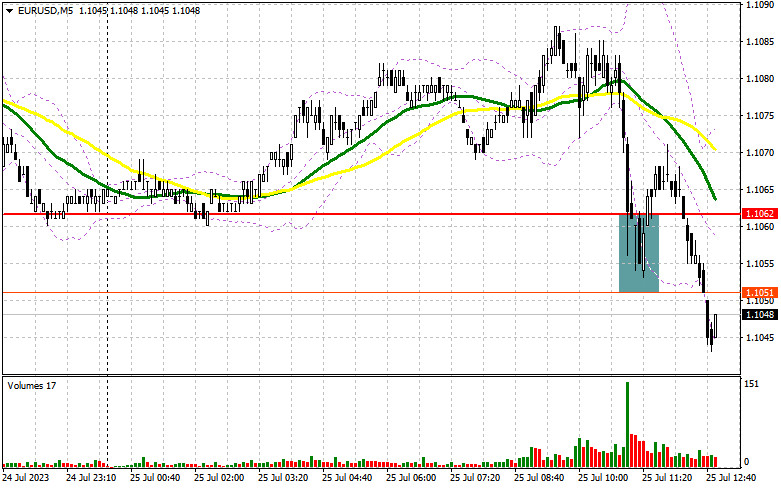
In the morning forecast, I highlighted the level 1.1062 and recommended basing trading decisions on it. Let's analyze the 5-minute chart to see what happened. The decline and the subsequent false breakout at 1.1062 indicated a buy signal for the euro, but a significant upward movement did not materialize. After the release of weak IFO data from Germany, the EUR/USD pair continued to fall, resulting in loss-taking. The technical picture remained unchanged for the second half of the day. Read below to understand the reasons.

To initiate long positions on EUR/USD:
The weak IFO data from Germany brought back selling pressure on the euro, leading to a new weekly low. This indicates that traders are still facing challenges after yesterday's reports, which indicated a potential slide in the eurozone's economy into a recession. Today's data from Germany served as a reminder of this once again. We are also expecting figures on the housing price index and the housing price index for the 20 largest cities from S&P/Case-Shiller. However, the manufacturing index from the Richmond Federal Reserve and the consumer confidence indicator will have a much more significant impact on the market. An increase in consumer confidence in the USA will likely result in another sell-off of EUR/USD. Due to this, I will take my time buying.
If trading remains below 1.1062, only a false breakout formation around the next support level at 1.1015 will provide an excellent entry point for long positions, aiming to target a return to the current support level at 1.1062, which previously acted as resistance in the morning. A breakthrough and a successful test of this range from top to bottom will restore demand for the euro, offering an opportunity to return to 1.1106, where the moving averages, favoring bears, are positioned. The ultimate target remains the 1.1146 level, where I will take profits. If EUR/USD declines and there is no significant activity at 1.1015 in the second half of the day, the bearish market's development will likely continue. Hence, only a false breakout formation around the next support level at 1.0981 will indicate a buy signal for the euro. I will enter long positions immediately after a rebound from the 1.0946 minimum, targeting an upward correction of 30-35 pips within the day.
To initiate short positions on EUR/USD:
Sellers still have a good chance to establish a further bearish market, especially after the morning data from Germany. In the event of weak reports from the USA, there might be a slight upward movement in EUR/USD towards 1.1062, as I generally expect. I will only act upon this level after a false breakout, which will serve as a sell signal with the prospect of EUR/USD declining to the new support level at 1.1015. At that point, I anticipate more substantial buyers to appear. In the case of a breakthrough and consolidation below this range, along with a reverse test from bottom to top, a sell signal may arise, opening a direct path to 1.0981, which can renew buyer interest. The ultimate target will be the 1.0946 level, where I will take profits. If EUR/USD moves up during the American session, and bears are absent at 1.1062, which is also a possibility, bulls will gain an advantage. In this scenario, I will postpone short positions until the next resistance at 1.1106. Selling might be possible, but only after an unsuccessful consolidation. I will enter short positions immediately after a rebound from the 1.1146 maximum, targeting a downward correction of 30-35 points.

Indicator signals:
Moving averages.
Trading below the 30 and 50-day moving averages indicates further euro decline.
Note: The period and prices of the moving averages discussed by the author are on the hourly chart (H1) and differ from the general definition of classical daily moving averages on the daily chart (D1).
Bollinger Bands:
In case of an upward trend, the upper boundary of the indicator around 1.1100 will act as resistance.
Description of Indicators:
• Moving Average (determines the current trend by smoothing volatility and noise). Period 50. Marked in yellow on the chart.
• Moving Average (determines the current trend by smoothing volatility and noise). Period 30. Marked in green on the chart.
• MACD Indicator (Moving Average Convergence/Divergence) - Fast EMA with a period of 12, Slow EMA with a period of 26, and SMA with a period of 9.
• Bollinger Bands - Period 20.
• Non-commercial traders - speculators, such as individual traders, hedge funds, and large institutions using the futures market for speculative purposes and meeting certain requirements.
• Long non-commercial positions represent the total long open position of non-commercial traders.
• Short non-commercial positions represent the total short open position of non-commercial traders.
• The overall non-commercial net position is the difference between non-commercial traders' short and long positions.